Characterization of Energy Profile and Load Flexibility in Regional Water Utilities for Cost Reduction and Sustainable Development
Abstract
1. Introduction
1.1. Overview and Motivation
1.2. Literature Review
1.3. Contribution
- Step-by-step data analytics was developed to discover, interpret, and visualize meaningful patterns from water industry energy consumption data. The developed method helped deliver a clean energy profile to characterize and identify energy flexibility for water utilities, especially in regional areas.
- The identified energy flexibility was used to explore the opportunities for cost reduction in the operation of water utilities through demand management. Several levels of demand management were considered to identify the quarterly and yearly savings of a water utility.
- The opportunities and benefits of installing solar and battery storage in the regional water industry sites were assessed for cost reduction and sustainable development.
- Recommendations are made for improving data coordination (interoperability) to enable the use of a single platform for identifying DR opportunities for different types of water utilities.
2. Methodology
- Step 1: Business Understanding
- Step 2: Data Mining
- Step 3: Data Cleaning
- Values beyond reasonable operational limits, possibly due to hardware errors.
- Missing values, possibly due to hardware errors or data collection at different time scales. For example, energy consumption was collected half-hourly, but some water pumps were collected hourly or nearly hourly.
- Time was not synchronized. The timing of the data could be out of synchronization because they were collected from different sources. To overcome this issue, we matched the events to energy consumption.
- Step 4: Data Exploration and Feature Engineering
- Step 5: Performing a Final Assessment
2.1. Data Classification and Diversity
2.2. Data Cleaning and Preparation
2.3. Wholesale and Retail Energy Tariff
2.4. Performance Index
2.5. Opportunity Assessment Process
3. Results
3.1. Data Acquisition
3.1.1. Data Selection and Processing
3.1.2. NEM Electricity Spot Price
3.2. Energy Profiling
3.3. Opportunity Assessment
3.3.1. DR Using Peak Load Shifting
3.3.2. Opportunity Assessment: Using Solar and Energy Storage
Site A1
Site B1
Site B2
4. Conclusions
- The energy and load profiles were characterized, revealing that most regional sites relied heavily on grid electricity.
- Three of the sites transitioned from an uneconomical state (EEI of more than one) to an economical state after a 5% peak load shift. The EEI values of one site remained above one even after a 20% peak load shift.
- Total savings increased by up to 60% with a 100% increase in PV with the existing battery size as the excess electricity could be utilized during peak hours rather than being exported to the grid.
Author Contributions
Funding
Institutional Review Board Statement
Informed Consent Statement
Data Availability Statement
Conflicts of Interest
Abbreviations
| AEMO | Australian Energy Market Operator |
| BOD | Biological Oxygen Demand |
| COD | Chemical Oxygen Demand |
| DR | Demand Response |
| DO | Dissolved Oxygen |
| EEI | Energy Efficiency Index |
| NEM | National Electricity Market |
| NMI | National Metering Identifier |
| NREL | National Renewable Energy Laboratory |
| NSRDB | National Solar Radiation Database |
| RES | Renewable Energy Sources |
| SAM | System Advisor Model |
| SBR | Sequencing Batch Reactor |
| SCADA | Supervisory Control and Data Acquisition |
| SILO | Scientific Information for Land Owners |
| SS | Suspended Solid |
| TWAP | Time-Weighted Average Price |
| VDO | Victorian Default Offer |
| VWAP | Volume-Weighted Average Price |
References
- Yan, G.; Kenway, S.J.; Lam, K.L.; Lant, P.A. Water-Energy Trajectories for Urban Water and Wastewater Reveal the Impact of City Strategies. Appl. Energy 2024, 366, 123292. [Google Scholar] [CrossRef]
- International Energy Agency. Introduction to the Water-Energy Nexus. Available online: https://www.iea.org/articles/introduction-to-the-water-energy-nexus (accessed on 30 January 2025).
- Capodaglio, A.G. Energy Use and Decarbonisation of the Water Sector: A Comprehensive Review of Issues, Approaches, and Technological Options. Environ. Technol. Rev. 2025, 14, 40–68. [Google Scholar] [CrossRef]
- Hasan, K.N.; Court, D.; Curtis, R.; Kashyap, S.; Jankovic, S.; Asayhe, A.; AlAbdali, A.; Anastassiou, M. Operating Cost Reduction by Electricity Profiling and Demand Management. Water Pract. Technol. 2020, 15, 921–931. [Google Scholar] [CrossRef]
- Yasmin, R.; Amin, B.M.R.; Shah, R.; Barton, A. A Survey of Commercial and Industrial Demand Response Flexibility with Energy Storage Systems and Renewable Energy. Sustainability 2024, 16, 731. [Google Scholar] [CrossRef]
- Amin, B.M.R.; Shah, R.; Hasan, K.N.; Tayab, U.B.; Islam, S. An Overview of Demand Response Opportunities for Commercial and Industrial Customers in the Australian NEM. In Proceedings of the 2022 IEEE PES 14th Asia-Pacific Power and Energy Engineering Conference (APPEEC), Melbourne, Australia, 20–23 November 2022; pp. 1–6. [Google Scholar]
- Zohrabian, A.; Plata, S.L.; Kim, D.M.; Childress, A.E.; Sanders, K.T. Leveraging the Water-Energy Nexus to Derive Benefits for the Electric Grid Through Demand-Side Management in the Water Supply and Wastewater Sectors. WIREs Water 2021, 8, e1510. [Google Scholar] [CrossRef]
- Van den Berg, C.; Danilenko, A.; World Bank. The IBNET Water Supply and Sanitation Performance Blue Book: The International Benchmarking Network for Water and Sanitation Utilities Databook; World Bank: Washington, DC, USA, 2011; 152p. [Google Scholar]
- Kenway, S.J.; Priestley, A.; Cook, S.; Seo, M.; Inman, A.; Gregory, A.; Hall, M. Energy Use in the Provision and Consumption of Urban Water in Australia and New Zealand; Water Services Association of Australia: Docklands, Australia, 2008. [Google Scholar]
- EPA—Environment Protection Authority. Where Do We Get Our Water? Available online: https://www.epa.sa.gov.au/soe-2018/inland-waters/where-do-we-get-our-water (accessed on 31 January 2025).
- Melbourne Water. Natural and Urban Water Cycle. Available online: https://www.melbournewater.com.au/education/community-resources/water-knowledge/natural-and-urban-water-cycle (accessed on 31 January 2025).
- Kizhisseri, M.I.; Mohamed, M.M.; Hamouda, M.A. A Mixed-Integer Optimization Model for Water Sector Planning and Policy Making in Arid Regions. Water Resour. Ind. 2022, 28, 100193. [Google Scholar] [CrossRef]
- Wabela, K.; Hammani, A.; Abdelilah, T.; Tekleab, S.; El-Ayachi, M. Optimization of Irrigation Scheduling for Improved Irrigation Water Management in Bilate Watershed, Rift Valley, Ethiopia. Water 2022, 14, 3960. [Google Scholar] [CrossRef]
- Tang, H.L.; Feng, J.; Zhou, S.Y. Reservoir Optimization Scheduling Driven by Knowledge Graphs. Electronics 2024, 13, 2283. [Google Scholar] [CrossRef]
- Infrastructure Australia. An Assessment of Australia’s Future Infrastructure Needs; Infrastructure Australia: Forrest, Australia, 2019. [Google Scholar]
- Beca Consultants Pty Ltd. Opportunities for Renewable Energy in the Australian Water Sector; Beca Consultants Pty Ltd.: Melbourne, Australia, 2015. [Google Scholar]
- Bolognesi, A.; Bragalli, C.; Lenzi, C.; Artina, S. Energy Efficiency Optimization in Water Distribution Systems. Procedia Eng. 2014, 70, 181–190. [Google Scholar] [CrossRef]
- Frijns, J.; Middleton, R.; Uijterlinde, C.; Wheale, G. Energy Efficiency in the European Water Industry: Learning from Best Practices. J. Water Clim. Change 2012, 3, 11–17. [Google Scholar] [CrossRef]
- Zhao, Y.; Liang, B.; Shaobo, D.; Ronnie, T.; Yang, W.; Fang, C.; George, M.; Tin, H.; Vitanage, D.; Corinna, D. Energy Saving Optimisation for Water Distribution Networks—Applying Intelligent Network Optimisation Models. Water E-J. 2019, 4, 1–9. [Google Scholar] [CrossRef]
- Strazzabosco, A.; Conrad, S.A.; Lant, P.A.; Kenway, S.J. Expert Opinion on Influential Factors Driving Renewable Energy Adoption in the Water Industry. Renew. Energy 2020, 162, 754–765. [Google Scholar] [CrossRef]
- Sowby, R.B. Increasing water and wastewater utility participation in demand response programs. Energy Nexus 2021, 1, 100001. [Google Scholar] [CrossRef]
- Martin-Candilejo, A.; Santillán, D.; Garrote, L. Pump Efficiency Analysis for Proper Energy Assessment in Optimization of Water Supply Systems. Water 2020, 12, 132. [Google Scholar] [CrossRef]
- Skoczko, I. Energy Efficiency Analysis of Water Treatment Plants: Current Status and Future Trends. Energies 2025, 18, 1086. [Google Scholar] [CrossRef]
- Melbourne Water. Melbourne Water Annual Report 2003/2004; Melbourne Water: Melbourne, Australia, 2004. [Google Scholar]
- Strazzabosco, A.; Kenway, S.J.; Lant, P.A. Quantification of Renewable Electricity Generation in the Australian Water Industry. J. Clean. Prod. 2020, 254, 120119. [Google Scholar] [CrossRef]
- Strazzabosco, A.; Kenway, S.J.; Conrad, S.A.; Lant, P.A. Renewable Electricity Generation in the Australian Water Industry: Lessons Learned and Challenges for the Future. Renew. Sust. Energy Rev. 2021, 147, 111236. [Google Scholar] [CrossRef]
- Grieser, B.; Sunak, Y.; Madlener, R. Economics of Small Wind Turbines in Urban Settings: An Empirical Investigation for Germany. Renew. Energy 2015, 78, 334–350. [Google Scholar] [CrossRef]
- Lopes, R.A.; Junker, R.G.; Martins, J.; Murta-Pina, J.; Reynders, G.; Madsen, H. Characterisation and Use of Energy Flexibility in Water Pumping and Storage Systems. Appl. Energy 2020, 277, 115587. [Google Scholar] [CrossRef]
- Zakariazadeh, A.; Ahshan, R.; Al Abri, R.; Al-Abri, M. Renewable Energy Integration in Sustainable Water Systems: A Review. Clean. Eng. Technol. 2024, 18, 100722. [Google Scholar] [CrossRef]
- Sharifzadeh, M.; Hien, R.K.T.; Shah, N. China’s Roadmap to Low-Carbon Electricity and Water: Disentangling Greenhouse Gas (GHG) Emissions from Electricity-Water Nexus via Renewable Wind and Solar Power Generation, and Carbon Capture and Storage. Appl. Energy 2019, 235, 31–42. [Google Scholar] [CrossRef]
- Skroufouta, S.; Baltas, E. Investigation of Hybrid Renewable Energy System (HRES) for Covering Energy and Water Needs on the ISLAND of Karpathos in Aegean Sea. Renew. Energy 2021, 173, 141–150. [Google Scholar] [CrossRef]
- Lima, D.; Appleby, G.; Li, L. A Scoping Review of Options for Increasing Biogas Production from Sewage Sludge: Challenges and Opportunities for Enhancing Energy Self-Sufficiency in Wastewater Treatment Plants. Energies 2023, 16, 2369. [Google Scholar] [CrossRef]
- Lu, X.X.; Li, K.P.; Xu, H.C.; Wang, F.; Zhou, Z.Y.; Zhang, Y.G. Fundamentals and Business Model for Resource Aggregator of Demand Response in Electricity Markets. Energy 2020, 204, 117885. [Google Scholar] [CrossRef]
- Tadokoro, H.; Koibuchi, H.; Takahashi, S.; Kakudou, S.; Takata, Y.; Moriya, D.; Sasakawa, M. Water Supply Control System for Smarter Electricity Power Usage Adopting Demand-Response Scheme. Water Supply 2020, 20, 140–147. [Google Scholar] [CrossRef]
- Menke, R.; Abraham, E.; Parpas, P.; Stoianov, I. Demonstrating Demand Response from Water Distribution System Through Pump Scheduling. Appl. Energy 2016, 170, 377–387. [Google Scholar] [CrossRef]
- Chitsaz, H.; Zamani-Dehkordi, P.; Zareipour, H.; Parikh, P.P. Electricity Price Forecasting for Operational Scheduling of Behind-the-Meter Storage Systems. IEEE Trans. Smart Grid 2018, 9, 6612–6622. [Google Scholar] [CrossRef]
- Fang, D.L.; Chen, B. Linkage Analysis for the Water-Energy Nexus of City. Appl. Energy 2017, 189, 770–779. [Google Scholar] [CrossRef]
- Chen, S.Q.; Chen, B. Urban Energy-Water Nexus: A Network Perspective. Appl. Energy 2016, 184, 905–914. [Google Scholar] [CrossRef]
- Patrick, A.O. The $16 Billion Plan to Beam Australia’s Outback Sun Onto Asia’s Power Grids. 2020. Available online: https://www.washingtonpost.com/climate-solutions/2020/08/10/australia-solar-energy-asia/ (accessed on 31 January 2025).
- Harrou, F.; Dairi, A.; Dorbane, A.; Sun, Y. Energy Consumption Prediction in Water Treatment Plants Using Deep Learning with Data Augmentation. Results Eng. 2023, 20, 101428. [Google Scholar] [CrossRef]
- Oulebsir, R.; Lefkir, A.; Safri, A.; Bermad, A. Optimization of the Energy Consumption in Activated Sludge Process Using Deep Learning Selective Modeling. Biomass BioEnergy 2020, 132, 105420. [Google Scholar] [CrossRef]
- Zairi, S.; Meddah, B.; Slimani, M. Optimisation of the Energy Consumption in Activated Sludge Treatment Plants Using Simulation Model. Int. J. Environ. Pollut. 2024, 74, 198–231. [Google Scholar] [CrossRef]
- Adibimanesh, B.; Polesek-Karczewska, S.; Bagherzadeh, F.; Szczuko, P.; Shafighfard, T. Energy Consumption Optimization in Wastewater Treatment Plants: Machine Learning for Monitoring Incineration of Sewage Sludge. Sustain. Energy Technol. 2023, 56, 103040. [Google Scholar] [CrossRef]
- Li, Z.H.; Zou, Z.H.; Wang, L.P. Analysis and Forecasting of the Energy Consumption in Wastewater Treatment Plant. Math. Probl. Eng. 2019, 2019, 8690898. [Google Scholar] [CrossRef]
- Harrou, F.; Cheng, T.Y.; Sun, Y.; Leiknes, T.; Ghaffour, N. A Data-Driven Soft Sensor to Forecast Energy Consumption in Wastewater Treatment Plants: A Case Study. IEEE Sens. J. 2021, 21, 4908–4917. [Google Scholar] [CrossRef]
- Zylka, R.; Dabrowski, W.; Malinowski, P.; Karolinczak, B. Modeling of Electric Energy Consumption During Dairy Wastewater Treatment Plant Operation. Energies 2020, 13, 3769. [Google Scholar] [CrossRef]
- Cheng, T.Y.; Harrou, F.; Kadri, F.; Sun, Y.; Leiknes, T. Forecasting of Wastewater Treatment Plant Key Features Using Deep Learning-Based Models: A Case Study. IEEE Access 2020, 8, 184475–184485. [Google Scholar] [CrossRef]
- Bagherzadeh, F.; Nouri, A.S.; Mehrani, M.J.; Thennadil, S. Prediction of Energy Consumption and Evaluation of Affecting Factors in a Full-Scale WWTP Using a Machine Learning Approach. Process Saf. Environ. 2021, 154, 458–466. [Google Scholar] [CrossRef]
- Alekseev, A.V. Study of the Forecasting Problem of Energy Consumption of Water Pumping Station. E3S Web Conf. 2019, 102, 03001. [Google Scholar] [CrossRef]
- SILO. Australian Climate Data from 1889 to Yesterday. Available online: https://www.longpaddock.qld.gov.au/silo/ (accessed on 31 January 2025).
- NREL. Available online: https://www.nrel.gov/ (accessed on 31 January 2025).
- Bureau of Meteorology. Water Data Transfer Format (WDTF). Available online: http://www.bom.gov.au/water/standards/wdtf/ (accessed on 31 January 2025).
- FIWARE. Smart Cities. Available online: https://www.fiware.org/ (accessed on 31 January 2025).
- Li, C.B.; Tang, S.W.; Cao, Y.J.; Xu, Y.J.; Li, Y.; Li, J.X.; Zhang, R.S. A New Stepwise Power Tariff Model and Its Application for Residential Consumers in Regulated Electricity Markets. IEEE Trans. Power Syst. 2013, 28, 300–308. [Google Scholar] [CrossRef]
- AEMO. Available online: https://aemo.com.au/en (accessed on 31 January 2025).
- Ram, B. Tariffs and Load Management—A Post, Privatisation Study of the UK Electricity Supply Industry. IEEE Trans. Power Syst. 1995, 10, 1111–1117. [Google Scholar] [CrossRef]
- Mcrae, M.R.; Scheer, R.M.; Smith, B.A. Integrating Load Management Programs into Utility Operations and Planning with a Load Reduction Forecasting System. IEEE Trans. Power Appar. Syst. 1985, 104, 1321–1325. [Google Scholar] [CrossRef]
- Palensky, P.; Dietrich, D. Demand Side Management: Demand Response, Intelligent Energy Systems, and Smart Loads. IEEE Trans. Ind. Inform. 2011, 7, 381–388. [Google Scholar] [CrossRef]
- ESC. Available online: https://www.esc.vic.gov.au/electricity-and-gas/prices-tariffs-and-benchmarks/minimum-feed-tariff/minimum-feed-tariff-review-2021-22 (accessed on 31 January 2025).
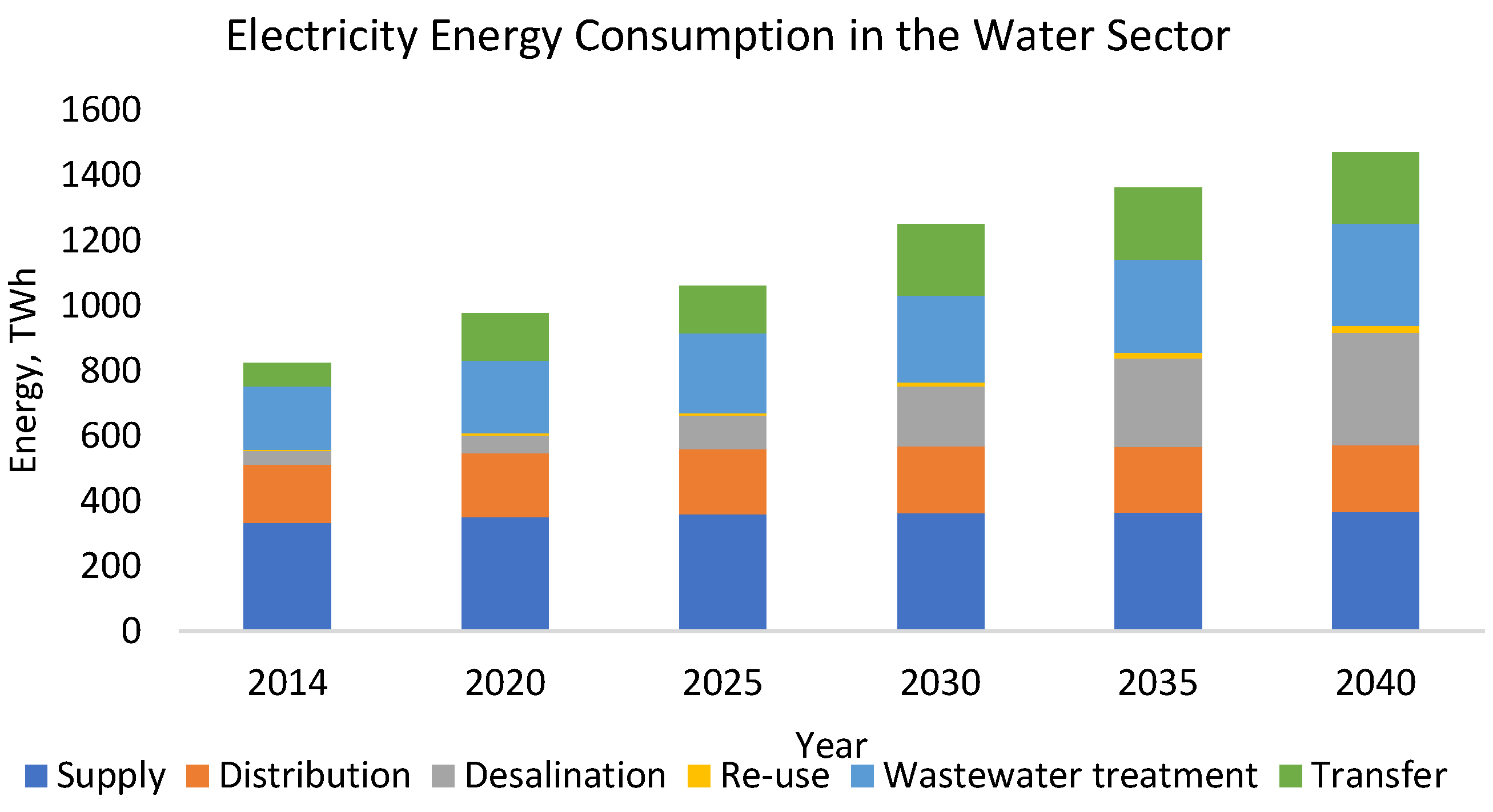

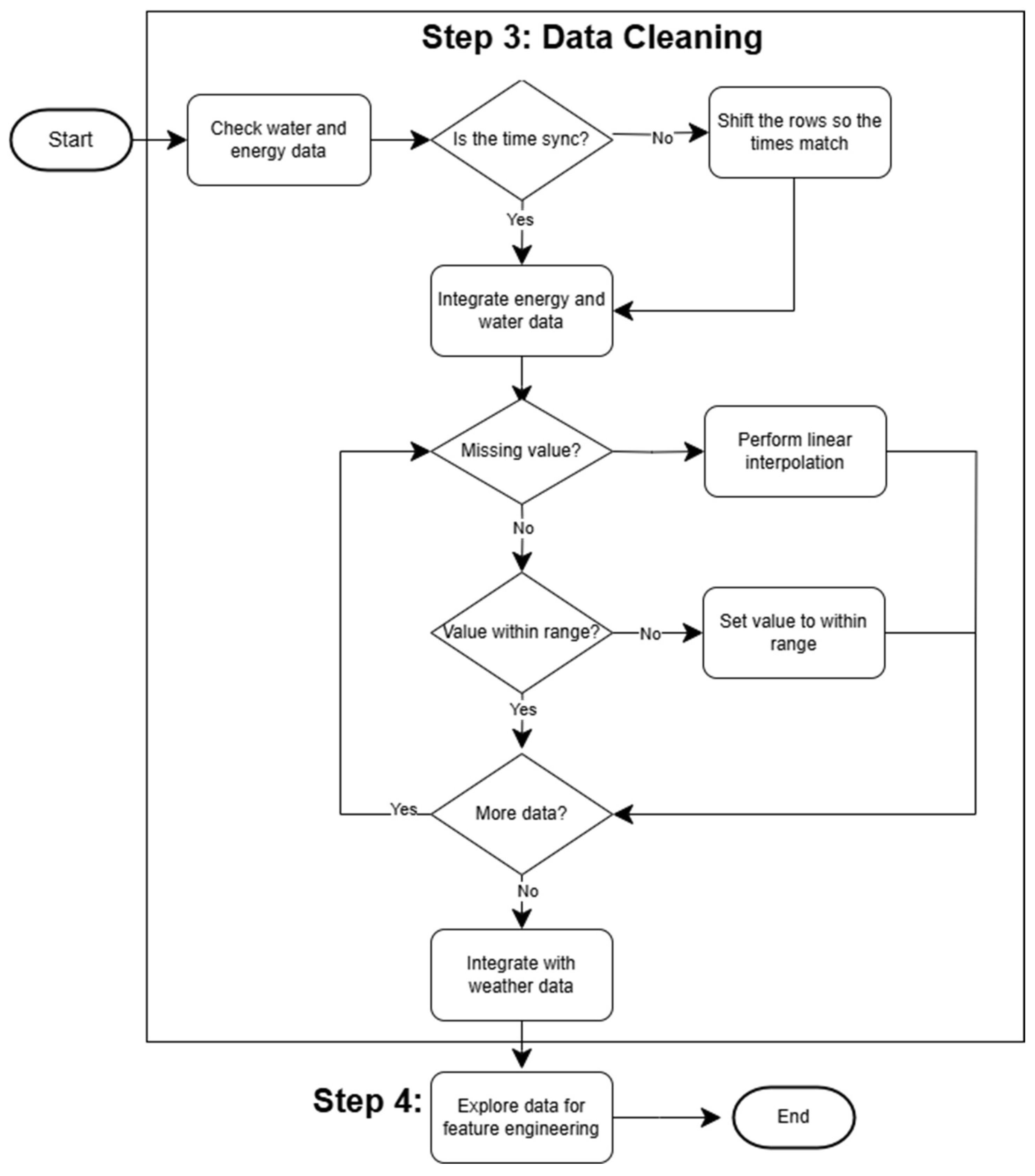
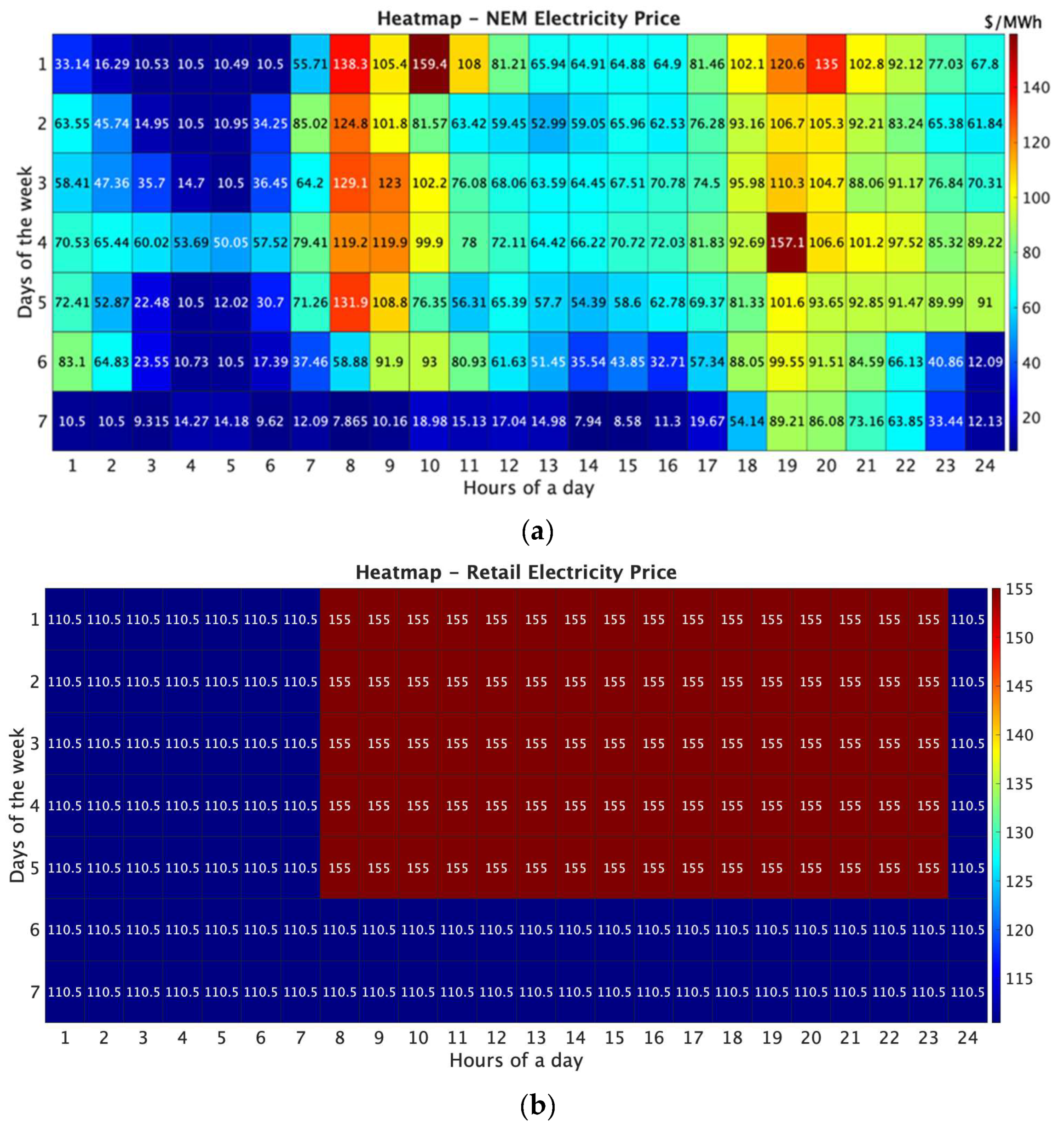

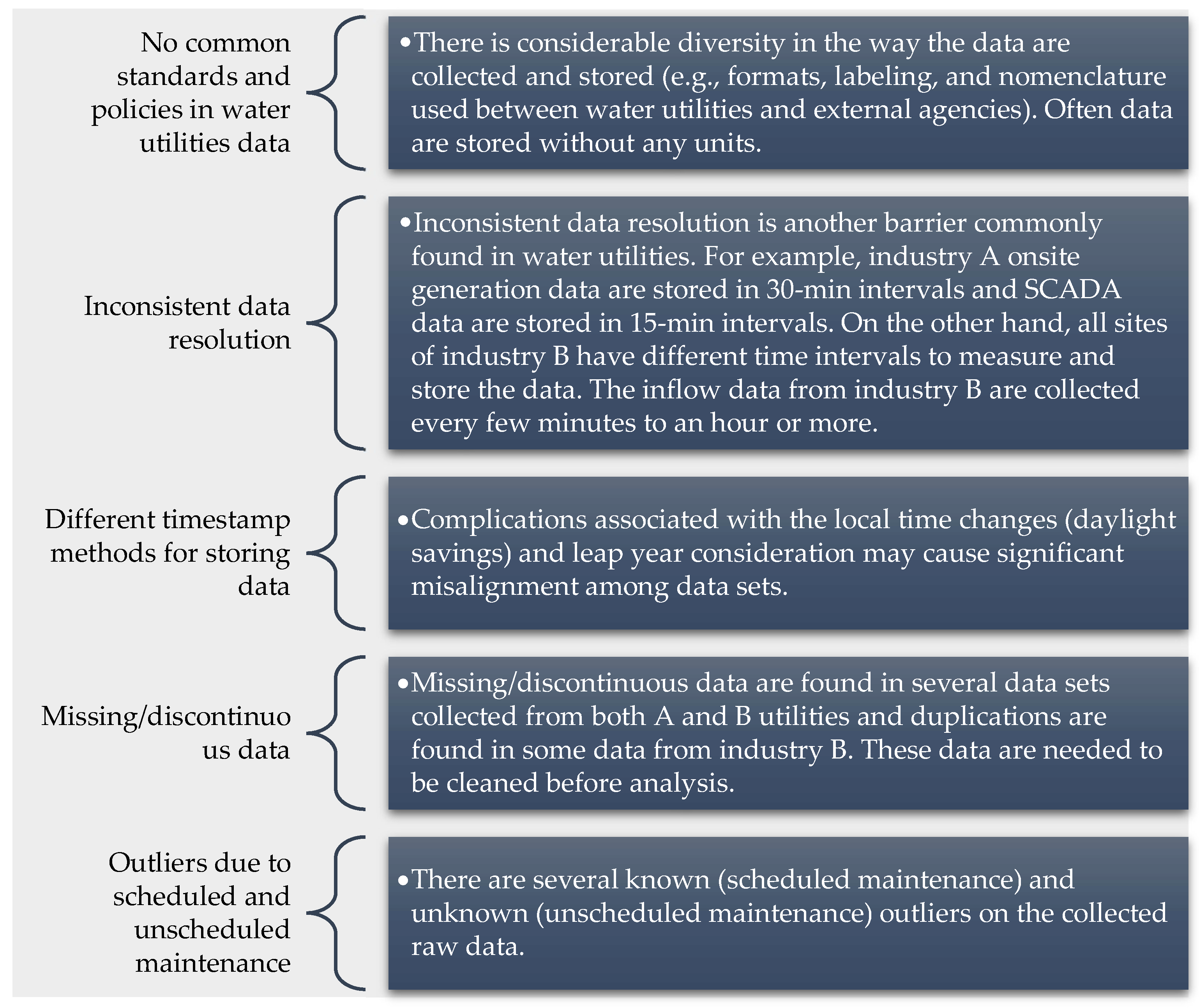

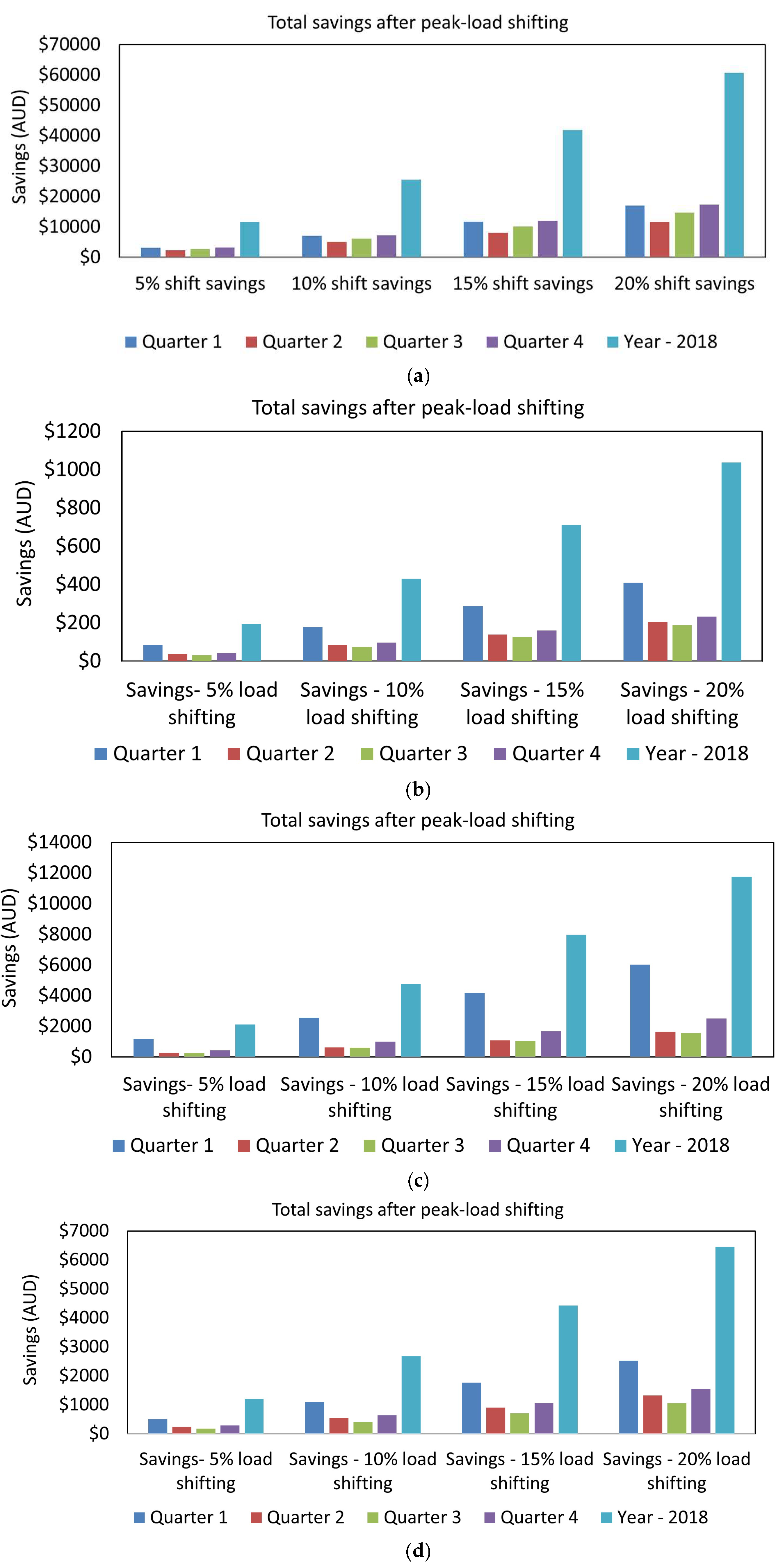
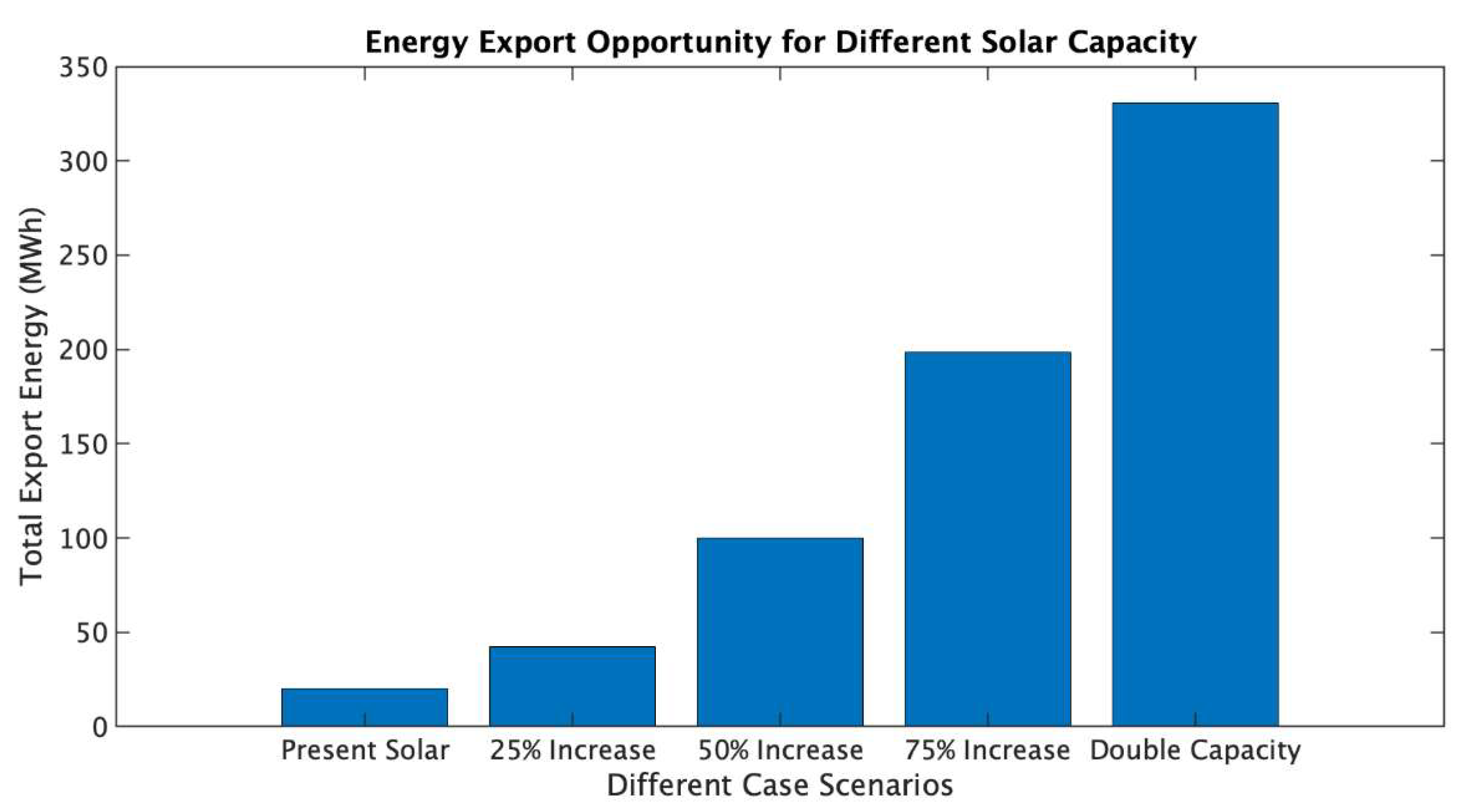
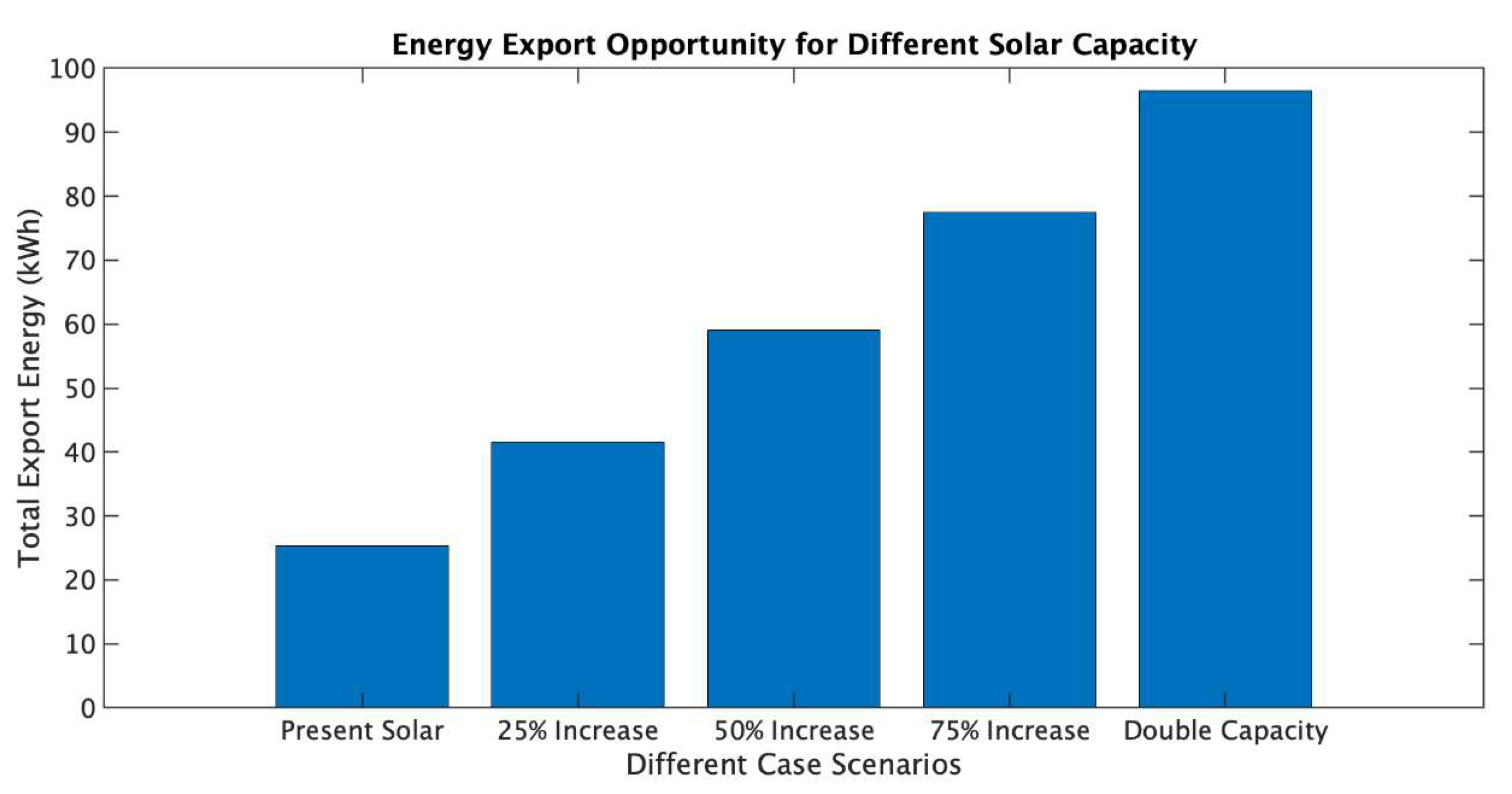
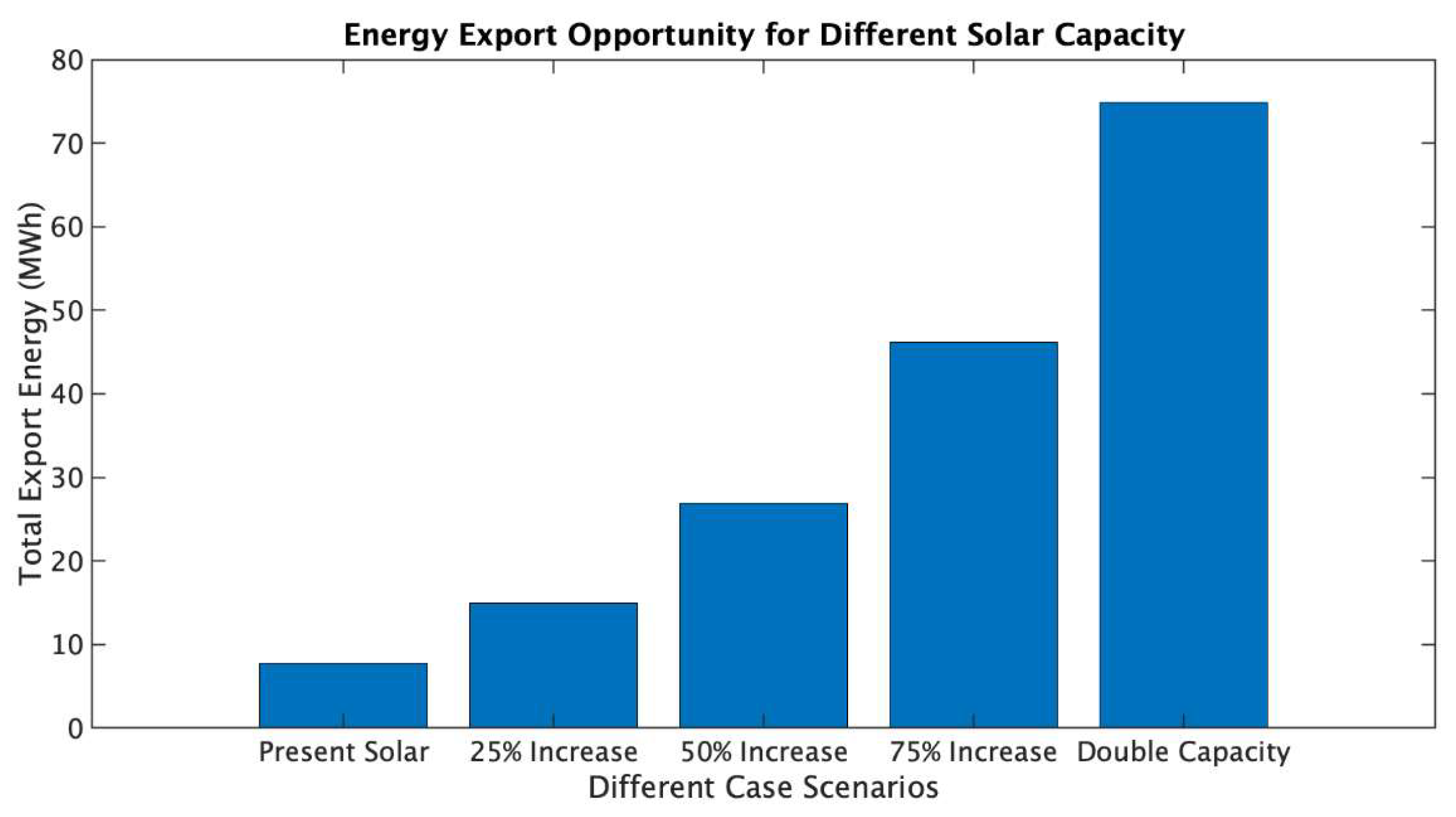
| Sites/ Period | EEI (Using Retail Price) | EEI (Using Wholesale Price) | ||||||
|---|---|---|---|---|---|---|---|---|
| A1 | B1 | B2 | B3 | A1 | B1 | B2 | B3 | |
| Q1 | 1.004 | 0.994 | 1.001 | 0.999 | 0.983 | 1.051 | 0.998 | 1.002 |
| Q2 | 0.995 | 0.997 | 0.999 | 0.999 | 1.005 | 1.002 | 0.958 | 0.988 |
| Q3 | 0.998 | 0.999 | 1.002 | 0.997 | 1.005 | 0.996 | 0.984 | 1.016 |
| Q4 | 1.002 | 0.995 | 1.001 | 0.996 | 1.004 | 1.003 | 0.990 | 1.006 |
| Annual | 0.990 | 1.002 | 1.038 | 1.003 | 0.995 | 1.021 | 1.016 | 1.008 |
| Sites/ Period | A1 | B1 | B2 | B3 | ||||||||||||
|---|---|---|---|---|---|---|---|---|---|---|---|---|---|---|---|---|
| 5% | 10% | 15% | 20% | 5% | 10% | 15% | 20% | 5% | 10% | 15% | 20% | 5% | 10% | 15% | 20% | |
| Q1 | 0.997 | 0.989 | 0.981 | 0.974 | 0.984 | 0.974 | 0.965 | 0.956 | 0.993 | 0.986 | 0.979 | 0.974 | 0.988 | 0.979 | 0.969 | 0.960 |
| Q2 | 0.984 | 0.974 | 0.965 | 0.955 | 0.991 | 0.985 | 0.979 | 0.973 | 0.997 | 0.995 | 0.993 | 0.990 | 0.994 | 0.987 | 0.982 | 0.976 |
| Q3 | 0.990 | 0.983 | 0.976 | 0.969 | 0.994 | 0.989 | 0.984 | 0.979 | 0.999 | 0.997 | 0.994 | 0.992 | 0.992 | 0.986 | 0.982 | 0.977 |
| Q4 | 0.994 | 0.986 | 0.979 | 0.972 | 0.987 | 0.981 | 0.974 | 0.968 | 0.997 | 0.994 | 0.991 | 0.989 | 0.988 | 0.982 | 0.975 | 0.969 |
| Annual | 0.982 | 0.975 | 0.967 | 0.959 | 0.995 | 0.987 | 0.981 | 0.974 | 1.033 | 1.028 | 1.024 | 1.019 | 0.996 | 0.988 | 0.981 | 0.974 |
| Sites/ Period | A1 | B1 | B2 | B3 | ||||||||||||
|---|---|---|---|---|---|---|---|---|---|---|---|---|---|---|---|---|
| 5% | 10% | 15% | 20% | 5% | 10% | 15% | 20% | 5% | 10% | 15% | 20% | 5% | 10% | 15% | 20% | |
| Q1 | 0.976 | 0.968 | 0.961 | 0.955 | 1.049 | 1.046 | 1.044 | 1.043 | 0.995 | 0.993 | 0.991 | 0.990 | 0.999 | 0.998 | 0.996 | 0.995 |
| Q2 | 0.999 | 0.992 | 0.997 | 0.981 | 0.996 | 0.990 | 0.984 | 0.978 | 0.952 | 0.947 | 0.942 | 0.937 | 0.981 | 0.975 | 0.969 | 0.963 |
| Q3 | 0.995 | 0.995 | 0.976 | 0.967 | 0.986 | 0.976 | 0.967 | 0.958 | 0.974 | 0.964 | 0.955 | 0.946 | 1.006 | 0.996 | 0.987 | 0.977 |
| Q4 | 1.000 | 0.997 | 0.994 | 0.991 | 0.999 | 0.997 | 0.994 | 0.991 | 0.987 | 0.983 | 0.981 | 0.978 | 1.002 | 0.999 | 0.996 | 0.993 |
| Annual | 0.988 | 0.982 | 0.976 | 0.969 | 1.016 | 1.011 | 1.010 | 1.002 | 1.012 | 1.010 | 1.003 | 1.000 | 1.003 | 0.998 | 0.993 | 0.989 |
| Sites/ Load Shifting | A1 | B1 | B2 | B3 | ||||
|---|---|---|---|---|---|---|---|---|
| Retail Price | Wholesale Price | Retail Price | Wholesale Price | Retail Price | Wholesale Price | Retail Price | Wholesale Price | |
| Original Cost | 1,214,498 | 1,147,504 | 22,401 | 16,714 | 250,766 | 174,371 | 137,653 | 97,296 |
| 5% | 11,570 | 8558 | 193 | 97 | 2270 | 889 | 1201 | 563 |
| 10% | 25,542 | 18,235 | 430 | 210 | 5040 | 1939 | 2677 | 1217 |
| 15% | 41,918 | 28,924 | 712 | 338 | 8311 | 3151 | 4426 | 1961 |
| 20% | 60,697 | 40,627 | 1037 | 482 | 12,082 | 4524 | 6448 | 2796 |
| Direct Capital Cost | O&M Cost | Lifetime (Year) | Inflation Rate | Discount Rate | |
|---|---|---|---|---|---|
| PV | 700 AUD/kW | 10 AUD/kW/year | 25 | 2.5%/year | 6.4%/year |
| BESS | 370 AUD/kWh, 270 AUD/kW | 15 AUD/kWh/year | 10 |
| Percent Solar Increase | Export to the Grid (MWh) | Savings by Exporting to the Grid (AUD) | Savings by Using Battery Storage (AUD) |
|---|---|---|---|
| Present capacity | 20.40 | 2019 | 3365 |
| 25% increase | 42.25 | 4182 | 6970 |
| 50% increase | 99.88 | 9888 | 16,480 |
| 75% increase | 198.49 | 19,650 | 32,751 |
| 100% increase | 330.91 | 32,760 | 54,600 |
| Percent Solar Increase | Export to the Grid (MWh) | Savings by Exporting to the Grid (AUD) | Savings by Using Battery Storage (AUD) |
|---|---|---|---|
| Present capacity | 25.33 | 2507 | 4178 |
| 25% increase | 41.52 | 4110 | 6850 |
| 50% increase | 59.05 | 5845 | 9743 |
| 75% increase | 77.49 | 7671 | 12,785 |
| 100% increase | 96.48 | 9551 | 15,918 |
| Percent Solar Increase | Export to the Grid (MWh) | Savings by Exporting to the Grid (AUD) | Savings by Using Battery Storage (AUD) |
|---|---|---|---|
| Present capacity | 7.73 | 765 | 1276 |
| 25% increase | 14.98 | 1482 | 2471 |
| 50% increase | 26.95 | 2667 | 4446 |
| 75% increase | 46.15 | 4569 | 7615 |
| 100% increase | 74.89 | 7413 | 12,356 |
Disclaimer/Publisher’s Note: The statements, opinions and data contained in all publications are solely those of the individual author(s) and contributor(s) and not of MDPI and/or the editor(s). MDPI and/or the editor(s) disclaim responsibility for any injury to people or property resulting from any ideas, methods, instructions or products referred to in the content. |
© 2025 by the authors. Licensee MDPI, Basel, Switzerland. This article is an open access article distributed under the terms and conditions of the Creative Commons Attribution (CC BY) license (https://creativecommons.org/licenses/by/4.0/).
Share and Cite
Amin, B.M.R.; Shah, R.; Lim, S.; Choudhury, T.; Barton, A. Characterization of Energy Profile and Load Flexibility in Regional Water Utilities for Cost Reduction and Sustainable Development. Sustainability 2025, 17, 3364. https://doi.org/10.3390/su17083364
Amin BMR, Shah R, Lim S, Choudhury T, Barton A. Characterization of Energy Profile and Load Flexibility in Regional Water Utilities for Cost Reduction and Sustainable Development. Sustainability. 2025; 17(8):3364. https://doi.org/10.3390/su17083364
Chicago/Turabian StyleAmin, B. M. Ruhul, Rakibuzzaman Shah, Suryani Lim, Tanveer Choudhury, and Andrew Barton. 2025. "Characterization of Energy Profile and Load Flexibility in Regional Water Utilities for Cost Reduction and Sustainable Development" Sustainability 17, no. 8: 3364. https://doi.org/10.3390/su17083364
APA StyleAmin, B. M. R., Shah, R., Lim, S., Choudhury, T., & Barton, A. (2025). Characterization of Energy Profile and Load Flexibility in Regional Water Utilities for Cost Reduction and Sustainable Development. Sustainability, 17(8), 3364. https://doi.org/10.3390/su17083364










